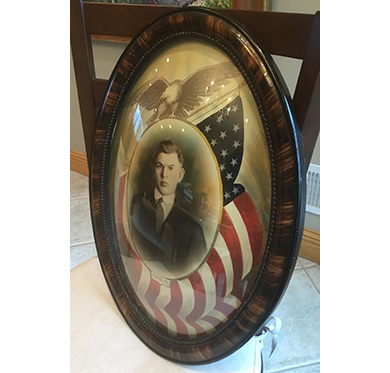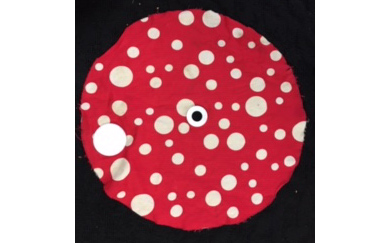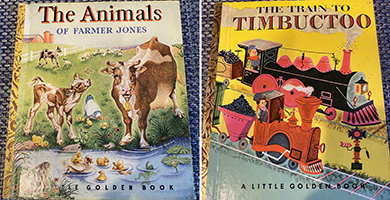 |
|
|||
 |
 |
|||
RINKER ON COLLECTIBLES — Column #1769 Copyright © Harry Rinker, LLC 2020 Questions
and Answers
QUESTION: My mother gave me a framed photograph of a young man whose image appears in an oval portion on the left side of an oval print of a spread-winged eagle above a waving American flag. The portrait back has a label for the Union Portrait Company, 4140 Trumbull Street, Bellaire, Ohio, “985,” and a notation the cost paid was $1.00. The oval wood frame has a plaster coating that has been marbleized. The glass is a curved dome. My mother thought this was a family member but could not remember who it was. Do you know if this is just a patriotic photograph or could it be someone who was in the U.S. Senate or House of Representatives? Is there a way to find out who it is? Any information would be greatly appreciated. – KT, Email Question 
ANSWER: There is a strong possibility that this is a family member (grandfather, great uncle, or another relative), most likely who served in the American military in World War I. Check your family genealogy to determine who may have served. Normally, one encounters individuals in this type of photograph wearing a military uniform. In this case, the picture may have been taken before the person left for service. Another alternative is that the young man (I estimate his age between 18-25) simply took advantage of an opportunity to have his photograph taken. Again, look back through your family genealogy, look for a male born between 1895 and 1900. I was assisted in researching your photograph by Rose Zelkowski, a staff member of the Bellaire Public Library. She found a May 12, 1919, classified advertisement in the “Bellaire Daily Leader” for two portrait agents selling portraits, lodge emblems, and photo jewelry. In 1919, 4140 Trumbull Street, Bellaire, Ohio, was a boarding house. Most likely the portrait agents rented rooms there while they were passing through Bellaire. “985” is a negative number. Unfortunately, I could find no surviving records for the Union Portrait Company. I did find a notation that a Union Portrait Company was headquartered in Detroit, Michigan, in 1895. No working dates were listed nor what type of photography the company performed. The value of your framed photograph is the frame. There is a demand for early 20th-century, marbleized-plaster wood frames with a dome glass. A frame in very good or better condition sells between $30.00 and $40.00. As to the value of the photograph, it is less than $5.00. Unidentified, it falls into the “instant ancestor” resale category. If someone is looking for a male relative who lived in or around Bellaire in 1919, they might consider paying a premium. Whether it is their exact relative or not makes little difference. Grandchildren and great grandchildren will believe whatever they are told, especially if the name of the ancestor should happen to be printed on the back. QUESTION: I have a Kuzan pizza pie spinning toy. It is flexible plastic disk with a hole in the center. The user puts a finger through the hole and twirls the disk as though it was pizza pie dough. There is a white button attached to the disk that reads: “PIZZA PIE / BY KUZAN.” It was one of the few toys my 65-year old husband had as a child. I am unable to find one like it anywhere on line. What can you tell me about it? – A & J, Email Question 
ANSWER: When instructing collectors, dealers, and others regarding dating an object, one of my favorite phrases is: “Do the math.” If your husband is 65, he most likely acquired the toy between the ages of two and three, thus in 1957 or 1958. Like you, my internet search for the Kuzan pizza pie spinning top was negative. In addition, I had trouble finding references to Kuzan toys. I did find listings on WorthPoint.com for a Kuzan US Army depressed toy train flat car with an M3 halftrack. I looked again at the button attached to the disk. You misread the name of the company. It is Kusan and not Kuzan. Nichols Industries, an American cap gun manufacturer, sold out to Kusan in 1965. In addition to cap guns, Kusan made a wide variety of children’s plastic toys in the 1960s and 1970s. These included a plastic gun capable of shooting ping-pong balls, a “Chunky” dump truck, Komet Rocketship Water gun, and #26-A race car. Most toys were generic off-brand items designed to be sold in Big Box discount chains, five and dimes, or drug stores. Checking WorthPoint.com again using “Kusan toys” instead of “Kuzan toys,” I found 7,277 listings. A “Kusan pizza pie disk” search proved negative. A “Kusan top” search produced over 450 listings, albeit most of them for yo-yos. There is minimal collector interest, with a few exceptions like Fisher-Price and Playskool, in infant toys. On the other hand, there are collectors for neat things. Your pizza pie spinning disk is a “neat” thing. A fair secondary market retail value for the Kusan spinning toy disk is between $2.50 and $5.00. Encourage your husband to keep playing with it. That is the spinning toy’s real value. t QUESTION: I am a New Zealand novelist currently working on a book that includes the use of a black light. It is set in the early 1980s. I am trying to figure out how readily available such a thing would have been then. Do you know how long black lights have been used in the antiques business? I am hoping that my character – a schoolgirl – could borrow a black light from an antiques dealer. – CC, University of Waikato, Hamilton, N.Z., Email Question ANSWER: In the late 1950s and early 1960s, I served as a cave guide at Lost River Caverns in Hellertown, Pennsylvania. In addition to providing tours of the cave, I worked in a mineral and gem shop that was part of the cave operation. The mineral and gem shop sold battery operated portable and electric black (ultra violet) lights. Antiques dealers, auctioneers, collectors, and museum personnel were aware that black lights could be used to detect painting changes in artwork and repairs to ceramics, furniture, and other objects. Black lights also were critical to identifying “Vaseline” glass which fluoresced a bright yellow-green because of its uranium content. By the mid-1990s, I owned several black lights which I used in the authentication courses that I taught auctioneers, collectors, and dealers at my Institute for the Study of Antiques and Collectibles. Given the above, if your schoolgirl asked to borrow a black light from a large-scale antiques or fine arts dealer, chances are her request would result in a positive response. QUESTION: I recently acquired a number of early Little Golden Books in a box lot I bought at auction. “The Train to Timbuctoo” with story by Margaret Wise Brown and pictures by Art Seiden was copyrighted in 1941 and has an “A” in the bottom right corner of the last page. “The Animals of Farmer Jones” with story by Leah Gale and pictures by Rudolf Freud was copyrighted in 1942 and has a “P” in the bottom right corner of the last page. I would like to sell them. What advice do you have? – DZ, CT, Email Question 
ANSWER: There are several considerations in terms of selling these books. The first is condition. If the books are not in very fine or better condition, they will be difficult to sell. The front cover and side binding should be near perfect. There should be no extra markings inside. Second, the edition printing is a value key. Little Golden Books printed through 1947 have the edition information printed on the front page. Starting in 1947, Simon and Schuster used a letter code to indicate printing. An “A” is the first printing. A “P” would be sixteenth edition. “The Train to Timbuctoo” with the “A” is not a first edition but one printed in 1947. The initial copyright date remained as part of the information on the front cover until the copyright expired. Third, the generations that grew up reading these titles have gown older. Reprints of many of the early Little Golden Book titles exist. The sad news is that most modern parents do not remember reading Little Golden Books as children nor do they buy them for their children. In addition, they no longer are found in most school libraries. Fourth, the survival rate for Little Golden Books is high. The secondary market is flooded. Fifth, the Golden Age of Little Golden Books collecting was in the 1990s. It has long passed. The former collectors club has now moved to Facebook, not a good sign. Finally, WorthPoint.com listings suggest these titles have a sell through rate between $8.00 and $12.00, assuming a buyer comes forward. Most examples listed on eBay remain unsold. Assuming you purchased these books in a box lot, you probably do not have more than $1.00 to $2.00 invested in them. My recommendation is to undercut all the “asking prices” you see on the internet and blow them out at $5.00 to $6.00 each. At these prices, you only have to sell one-quarter to one-third of the pile to recover your initial purchase cost. Harry L. Rinker welcomes questions from readers about
collectibles, those mass-produced items from the twentieth and twenty-first centuries.
Selected letters will be answered in this column.
Harry cannot provide personal answers.
Photos and other material submitted cannot be
returned.
Send your questions to: Rinker on Collectibles, 5955 Mill
Point Court SE, Kentwood, MI 49512.
You also can e-mail your questions to
harrylrinker@aol.com.
Only e-mails containing a full name and mailing address
will be considered.
|
||||